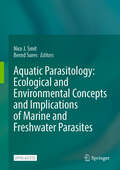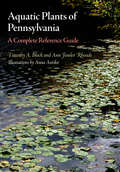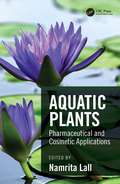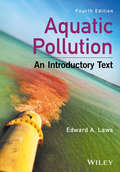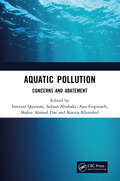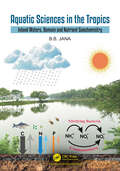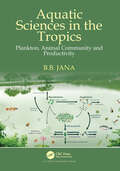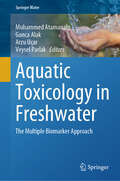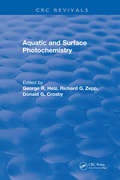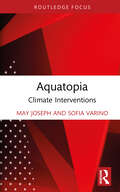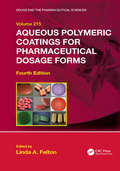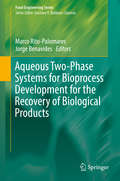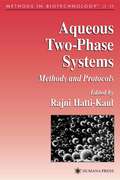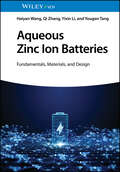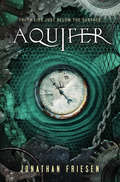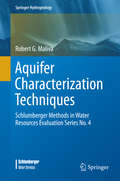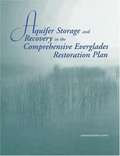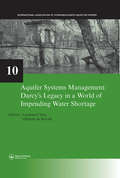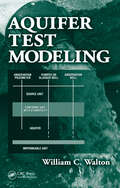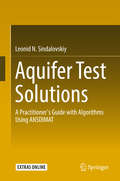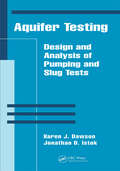- Table View
- List View
Aquatic Organic Matter Fluorescence
by Paula G. Coble Jamie Lead Andy Baker Darren M. Reynolds Robert G. M. Spencer Paula G. Coble Jamie Lead Andy Baker Darren M. ReynoldsThis is the first comprehensive text on the theory and practice of aquatic organic matter fluorescence analysis, written by the experts who pioneered the research area. This book covers the topic in the broadest possible terms, providing a common reference for making measurements that are comparable across disciplines, and allowing consistent interpretation of data and results. The book includes the fundamental physics and chemistry of organic matter fluorescence, as well as the effects of environmental factors. All aspects of sample handling, data processing, and the operation of both field and laboratory instrumentation are included, providing the practical advice required for successful fluorescence analyses. Advanced methods for data interpretation and modeling, including parallel factor analysis, are also discussed. The book will interest those establishing field, laboratory, or industrial applications of fluorescence, including advanced students and researchers in environmental chemistry, marine science, environmental geosciences, environmental engineering, soil science, and physical geography.
Aquatic Parasitology: Ecological and Environmental Concepts and Implications of Marine and Freshwater Parasites
by Nico J. Smit Bernd SuresThis open access volume is the first to provide a comprehensive overview of the ecological and environmental characteristics of marine and freshwater parasites. In three clearly organized sections, world-leading authors present the current state of our knowledge as well as the future trends for their respective fields in aquatic parasitology. First, the basic life cycle strategies of the various major groups of aquatic parasites are presented, including protists, myxozoa, aquatic fungi, helminths, and arthropods. Subsequent chapters explore the ecological implications of aquatic parasites covering topics such as biodiversity, evolution, community structures, behavior, and conservation - to name a few. In addition, important developments in research are presented, such as the use of different molecular tools and eDNA in aquatic parasitology. The final section is devoted to the new field of environmental parasitology, where readers will find contributions on biological markers, invasive species, and bioindicators of environmental pollution, among others. Due attention is also given to zoonoses, aquaculture, and the effects of climate change on aquatic parasites. All chapters include original high-quality illustrations and never-before-seen photographs which complement the diverse aspects of aquatic parasitology described. Thus, this book is a must for every parasitologist and ecologist.
Aquatic Physiosphere-Biosphere Dynamics and Modelling: A Reference for Studies of the Coupled System
by Aike BeckmannThis encyclopedia is a reference for aquatic physical, biological and biogeochemical sciences, collecting and connecting a number of topics, concepts and facts about aquatic systems and their scientific investigation. The scope of the book comprises the aquatic physiosphere-biosphere transition zone, an entity that encompasses both inanimate matter and collectives (the physiosphere) as well as living organisms and collectives (the biosphere). This combined approach is meaningful because both realms are intimately linked and because available methods of investigation are often similar. Much can be gained from considering both spheres at and across their interface jointly, and while there is a strong focus on marine systems, most concepts presented are also applicable to freshwater systems. This presented snapshot of knowledge of the transition zone between the aquatic physiosphere and biosphere is taken from a very specific angle: the point of view of a modeler. Modeling is not only a state-of-the-art mode of scientific investigation, but also requires the explicit specification of all assumptions (helping to avoid fallacies), and offers the advantage of being quantitative and allows for theoretical "what if" scenarios.As in any reference work, equal emphasis is given to fundamental facts, the definition of terms and the explanation of concepts, in an attempt to establish a joint language for physicists, biologists and biogeochemists. Although originating from a modeler's approach to nature, the resulting suite of compatible concepts may also be useful beyond modeling purposes. Furthermore, the material is presented in a condensed, straightforward way. Hence, the length of each entry is limited to one (occasionally two) pages, thus offering a quick introductory overview. This excludes lengthy derivations and very specialized details. The book is geared towards researchers, teachers and advanced students in the field of aquatic (marine and limnic) sciences, in particular those interested or involved in interdisciplinary work.
Aquatic Plants of Pennsylvania: A Complete Reference Guide
by Timothy A. Block Ann Fowler RhoadsFrom the Delaware River to the shores of Lake Erie, Pennsylvania's diverse watery habitats are home to more than 200 species of aquatic plants. In Aquatic Plants of Pennsylvania: A Complete Reference Guide, botanists Timothy A. Block and Ann Fowler Rhoads have assembled the first identification guide specific to the Keystone State yet useful throughout the Mid Atlantic region. Organized and written in a way that will make information easily accessible to specialists and nonspecialists alike, the book highlights the diversity and vital ecological importance of this group of plants, providing photographs, illustrations, descriptions, and identification keys for all emergent, floating-leaved, and submergent aquatic plants found in the Commonwealth.An introductory chapter on aquatic plant ecology covers topics such as evolution, form, and reproduction of aquatic plants, vegetation zones, types of aquatic ecosystems, and rare and endangered species. Information on invasive plants, such as Eurasian water-milfoil and curly pondweed, that threaten Pennsylvania's aquatic ecosystems will be especially useful to watershed organizations, citizen monitoring projects, lake managers, and natural resource agency personnel. An illustrated identification key guides the reader through a series of steps to properly identify a specimen based on its characteristics. Each of the more than 200 listings provides a plant's taxonomy, detailed description, distribution map, and expert botanical illustrations. Many also include color photographs of the plants in their natural habitats.
Aquatic Plants: Pharmaceutical and Cosmetic Applications
by Namrita LallAquatic Plants: Pharmaceutical and Cosmetic Applications provides a concise description of popular aquatic plants found across the globe. The chapters in this beautifully illustrated, full-color book focus on the aquatic species native to specific continents. Written by a global team of experts, this book explains the distribution, ethnobotanical uses, genome sequencing, chemical compounds, and biological activity of these plants and addresses the cultivation and sustainable production of aquatic and wetland plants. Features: Describes the biological activity of a large collection of aquatic plants. Color photographs highlight each plant’s ethnobotanical characteristics, and structural formulae show their chemical constituents. Contributions come from leading scientists from countries including the United States, India, Mauritius, South Africa, and Cyprus. Aquatic Plants: Pharmaceutical and Cosmetic Applications is a valuable resource for academics conducting research on aquatic plants and for professionals in the pharmaceutical and cosmetic industries who are involved with the therapeutic applications of these plants and their sustainable usage.
Aquatic Pollution: An Introductory Text
by Edward A. LawsSince the publication of the third edition of Aquatic Pollution in 2000, there have been many major developments within the field in terms of research, regulations, and also large-scale catastrophes that have had a significant impact on the aquatic environment; the Deepwater Horizon oil spill and the Fukushima nuclear disaster have taken their toll, and research on ocean acidification has developed enormously over the last decade. Recognizing, controlling, and mitigating aquatic pollution on a global scale is one of the most important and most difficult challenges facing society today.Fully updated to reflect current understanding and discussing these major recent developments, this fourth edition of Aquatic Pollution covers every aspect of pollution associated with urban runoff, acid rain, sewage disposal, pesticides, oil spills, nutrient loading, and more. Case studies of major pollution sites, all original to this new edition, help to illustrate points made in general discussion.Offering unprecedented depth of coverage, and discussing both fresh and sea water environments, this unique text provides a key teaching and learning tool for courses in environmental science, zoology, oceanography, biology, and civil or sanitary engineering, as well as a vital book for government policy makers. It is also an excellent primer for policymakers and activists focused on environmental issues.
Aquatic Pollution: Concerns and Abatement
by Imtiyaz Qayoom Adnan Abubakr Anu Gopinath Shabir A. Dar Keezia KhurshidThis book discusses the sources, mechanism, impact and abatement of pollution in waterbodies and lays a base foundation for further research. In this book, readers will also get acquainted with the methods of decontamination of lakes by phytoremediation, pesticide removal techniques from lakes, toxic site reclamation and environmental sustainability using microbial aspects associated with clean-up of wastes.Based on the issues related to pollution of aquatic environments, the subject matter of this book includes: Nanoplastic Pollutants Affecting Fisheries Sector All Over the World Freshwater Floral Diversities as Pollution Indicators Radioactive Waste: Sources and Impact on Environment Environmental Sustainability Using Microbial Aspects Associated With Clearing Up Waste Nitrates and Phosphates: Boon or Bane for Waterbodies Print edition not for sale in South Asia (India, Sri Lanka, Nepal, Bangladesh, Pakistan and Bhutan)
Aquatic Sciences in the Tropics: Inland Waters, Domain and Nutrient Geochemistry
by B.B. JanaThe tropical environment is unique due to its geographic location, climatic features, intense solar radiation, high temperature, heavy precipitation, less seasonal variation, enhanced food and productivity, faster metabolism, ecological dynamics and co-evolutionary processes that favor niches for specialized species. It also provides the richest biodiversity with endemic fish species that support millions of people in rural areas. This book Aquatic Sciences in the Tropics: Inland Waters, Domain and Nutrient Geochemistry comprises nine primary chapters that address various topics. Chapter 1 covers topics such as Water as a Substance, Water as a Medium, Fundamentals of Global Water Distribution and Hydrologic Cycle, Economics of Water and Challenges; Chapter 2: The Environment, Tropical Environment, Concept of Biosphere and Aquatic Biome, Tropical Aquatic Bionetwork, Tropical Limnology; Chapter 3: Origin of Lakes, General Classification of Lakes, Tropical Lakes, Lake Morphometry, Morpho-Edaphic Index, Trophic State Index of Lakes, Wetlands, Mangroves; Chapter 4: Concept of Stream Order, Streams and Rivers, The River Continuum Concept, Physico-chemical and Biological Features of Streams, Adaptations of Hill Stream Fishes; Chapter 5: Light as an Entity, Thermal Regime, Thermal Stratification, Lake Mixing, Turnover and Circulation; Chapter 6: Sources of CO2 in Inland Waters, Hydrogen Ion Concentration, The CO2–CO3–HCO3 System, Alkalinity, Hardness; Chapter 7: Dissolved Oxygen, Oxidation and Reduction Potential; Chapter 8: Total Dissolved Solids, Dissolved Organic Carbon; Chapter 9: Origin of Atmospheric Gases, Carbon and Carbon Cycle, Nitrogen, Nitrogen Fixation, Ammonification, Nitrification and Comammox, Denitrification and Anammox, Phosphorus and Sulphur.It is anticipated that the academic community, students, teachers, instructors, researchers, colleges, universities, institutions, administrators, policy makers, public libraries and the general public with an interest in these topics will find this text to be a valuable source of information and provide in-depth knowledge.
Aquatic Sciences in the Tropics: Plankton, Animal Community and Productivity
by B. B. JanaThe anatomy of water, water as a substance, water as a medium, the principles of the hydrologic cycle, the economics of water, and challenges are all covered in the first chapter of this book. The horizon of the tropical world, the environment, particularly the tropical environment, aquatic biome, tropical aquatic bionetwork, concept of biosphere, and tropical limnology are all covered in the second chapter. The third chapter covers the following topics: the origins of lakes, general lake classification, tropical lakes, lake morphometry, morpho-edaphic index, trophic status index of lakes, wetlands, and mangroves in tropical regions. The lotic environment is the main topic of the fourth chapter, which also covers the idea of stream order, the differences between rivers and streams, the river continuum, physical, chemical, and biological characteristics, and adaptations of fish found in hill streams. Chapter five covers the prokaryota, cyanobacteria, freshwater biota, and water-adapted organisms. The sixth chapter focuses on the algal communities Xanthophyceae, Euglenophyceae, Bacillariophyceae, Chrysophyceae, Phaeophyceae (brown algae), and Chlorophyceae. The seventh and last chapter covers the following topics: Protozoa, Porifera, Rotifera, Coelenterata, Annelida, Arthropoda, Crustacea, Aquatic Insects, Mollusca, Echinodermata, and Brachiopodaa.
Aquatic Toxicology in Freshwater: The Multiple Biomarker Approach (Springer Water)
by Muhammed Atamanalp Gonca Alak Arzu Uçar Veysel ParlakThis book will provide an important source of practical information on the history of toxicology, the ways in which pollutants reach model organisms used in toxicology, sampling methods for research, mechanisms of toxicity and responses of aquatic organisms to toxic agents, as well as the use of therapeutic agents in current approaches. Determining the importance of environmentally friendly substances on antioxidant defense is an obvious area of future research.The combined use of a biomarkers range that can indicate exposure to pollutants and measure their effects on living organisms enables a more comprehensive and integrative assessment of indicator organisms in the aquatic environment, both biochemically and cellularly. In conclusion, the multiple biomarker approach had received great interest in ecotoxicological research and had recently been adapted to both field and laboratory studies.
Aquatic and Surface Photochemistry
by George R. HelzAquatic and Surface Photochemistry provides a broad overview of current research in the emerging field of environmental aquatic and surface photochemistry. Selected reviews and current research articles are blended to provide an in-depth treatment of various aspects of this research area. The first part of the text deals with photochemistry in the environment, covering recent research on the following topics: aquatic photochemistry of organic pollutants and agrochemicals, photochemical cycling of carbon and transition metals (especially iron), photochemical formation of reactive oxygen species in natural waters, photoreaction in cloud and rain droplets, and photoreactions on environmental surfaces (soil, ash, metal, oxide). The second part provides discussions and data on both heterogeneous photocatalytic and homogeneous processes, with topics ranging from applications to mechanistic studies. These chapters illustrate the wide diversity of pollutant classes that are degradable by photochemical techniques and the effects of various reaction conditions on the rates and efficiency of the techniques. Current kinetic studies are presented, which provide new information about the role of adsorption and the nature of the reactive oxidizing species that mediate these photoremediation processes.This book will interest civil, chemical, and environmental engineers, as well as chemists, soil scientists, geochemists, and atmospheric chemists.
Aquatopia: Climate Interventions (Critical Climate Studies)
by May Joseph Sofia VarinoAquatopia documents Harmattan Theater’s ecological interventions and traces its engagements with water-bound landscapes, colonial histories, climate change, and public space across New York City, Venice, Amsterdam, Lisbon, and Cochin. The volume uses Harmattan’s site-specific performances as a point of departure to consider climate change and rising sea levels as geographical, ecological, and urban phenomena. Instead of a collection of flat, static surfaces, the Aquatopia atlas is animated by a disorienting, anti-mapping strategy, producing a deterritorialized, nomadic, fluid atlas unfolding in real time as an archive of climate change in multidimensional, active space. The book is designed for pedagogical access, with interludes that consolidate the learning outcomes of the experimental theory animating each site-specific performance. Accompanied by close descriptions of five performances and supplemented by digital documentation available online, this volume intervenes in discussions on climate change, urbanism, and postcolonization/decolonialization, and contributes to interdisciplinary studies of ecology and environmental politics, postcolonial/decolonial theories and practices, performance studies and aesthetics, in particular public art, and performance as research.
Aqueous Phase Adsorption: Theory, Simulations and Experiments
by Nishith Verma Jayant SinghThis book covers theoretical aspects of adsorption, followed by an introduction to molecular simulations and other numerical techniques that have become extremely useful as an engineering tool in recent times to understand the interplay of different mechanistic steps of adsorption. Further, the book provides brief experimental methodologies to use, test, and evaluate different types of adsorbents for water pollutants. Through different chapters contributed by accomplished researchers working in the broad area of adsorption, this book provides the necessary fundamental background required for an academician, industrial scientist or engineer to initiate studies in this area. Key Features Explores fundamentals of adsorption-based separation Provides physical insight into aqueous phase adsorption Includes theory, molecular and mesoscopic level simulation techniques and experiments Describes molecular simulations and lattice-Boltzmann method based models for aqueous phase adsorption Presents state-of-art experimental works particularly addressing removal of "emerging pollutants" from aqueous phase
Aqueous Polymeric Coatings for Pharmaceutical Dosage Forms (Drugs and the Pharmaceutical Sciences)
by Linda A. FeltonAqueous-based film coating has become routine in the pharmaceutical industry. This process eliminates the use of organic solvents and thus avoids economic, environmental, and toxicological issues related to residual solvents and solvent recovery. Aqueous-based coating, however, is complex and many variables may impact the final product and its performance. This fourth edition of Aqueous Polymeric Coatings for Pharmaceutical Dosage Forms aims to provide insight into the factors and parameters that should be considered and controlled for the successful development and commercialization of a coated product. The fourth edition has been revised and expanded to reflect the most recent scientific advancements from the literature. The contributing authors explain in detail, using illustrated examples, appropriate steps to solve and ideally avoid formulation, processing, and stability problems and to achieve an optimized dosage form. Trade names and chemical names of commercially marketed coatings are used throughout the text to help familiarize the reader with the various materials available for pharmaceutical applications. This book will be a valuable resource for anyone in the pharmaceutical industry working in the area of aqueous-based film coating.
Aqueous Pretreatment of Plant Biomass for Biological and Chemical Conversion to Fuels and Chemicals
by Charles E. WymanPlant biomass is attracting increasing attention as a sustainable resource for large-scale production of renewable fuels and chemicals. However, in order to successfully compete with petroleum, it is vital that biomass conversion processes are designed to minimize costs and maximize yields. Advances in pretreatment technology are critical in order to develop high-yielding, cost-competitive routes to renewable fuels and chemicals.Aqueous Pretreatment of Plant Biomass for Biological and Chemical Conversion to Fuels and Chemicals presents a comprehensive overview of the currently available aqueous pretreatment technologies for cellulosic biomass, highlighting the fundamental chemistry and biology of each method, key attributes and limitations, and opportunities for future advances.Topics covered include:* The importance of biomass conversion to fuels* The role of pretreatment in biological and chemical conversion of biomass* Composition and structure of biomass, and recalcitrance to conversion* Fundamentals of biomass pretreatment at low, neutral and high pH* Ionic liquid and organosolv pretreatments to fractionate biomass* Comparative data for application of leading pretreatments and effect of enzyme formulations* Physical and chemical features of pretreated biomass* Economics of pretreatment for biological processing* Methods of analysis and enzymatic conversion of biomass streams* Experimental pretreatment systems from multiwell plates to pilot plant operations This comprehensive reference book provides an authoritative source of information on the pretreatment of cellulosic biomass to aid those experienced in the field to access the most current information on the topic. It will also be invaluable to those entering the growing field of biomass conversion.
Aqueous Two-Phase Systems for Bioprocess Development for the Recovery of Biological Products (Food Engineering Series)
by Marco Rito-Palomares Jorge BenavidesThis comprehensive and unique text presents a full overview of downstream processing useful for those new to the concept as well as professionals with experience in the area. The history and theoretical principles of Aqueous Two-Phase Systems (ATPS) are covered in depth. Information on ATPS characterization and application is included, and ATPS equilibria and system parameters that have significant effect on partition behavior are studied. Aqueous Two-Phase Systems for Bioprocess Development for the Recovery of Biological Products addresses specific applications of ATPS for the recovery and partial purification of high molecular weight compounds such as proteins, nucleic acids and polysaccharides, particulate bioproducts such as cells and organelles and low molecular weight compounds. Non-conventional strategies involving ATPS such as affinity systems, continuous liquid-liquid fractionation stages and the recovery from plant extracts are presented. Economic analysis of the application of ATPS in comparison to other fractionation techniques, particularly liquid chromatography, is considered, as are opportunity and current trends in the ATPS research area. Each chapter utilizes the contributors' experimental expertise in traditional and non-conventional ATPS strategies, as well as analysis of areas of opportunity and perspectives on the development and future applications of ATPS in both the lab and larger scale operations. The result is a thorough and singular overview of ATPS which has not been matched by any other text on the market.
Aqueous Two-Phase Systems: Methods and Protocols (Methods in Biotechnology #11)
by Rajni Hatti-KaulRajni Hatti-Kaul and her expert coauthors combine theory, methodology, and applications in a practical collection of easily reproducible protocols for bioseparations in aqueous two-phase systems (ATPS). The protocols range from established methods to cutting-edge techniques with potential biotechnological applications. Among the methods detailed are those for ATPS preparation and characterization, for partitioning applied to soluble molecules and particulates (including whole cells, membranes, and organelles), and for the isolation and purification of proteins-including a glimpse of large-scale handling of two-phase separations. Practical and informative, with its detailed guidelines allowing researchers to adapt specific systems to their own separation needs, Aqueous Two-Phase Systems: Methods and Protocols demonstrates the scope and utility of two-phase aqueous systems in both basic and applied research.
Aqueous Zinc Ion Batteries: Fundamentals, Materials, and Design
by Haiyan Wang Qi Zhang Yougen Tang Yixin LiAqueous Zinc Ion Batteries Pioneering reference book providing the latest developments and experimental results of aqueous zinc ion batteries Aqueous Zinc Ion Batteries comprehensively reviews latest advances in aqueous zinc ion batteries and clarifies the relationships between issues and solutions for the emerging battery technology. Starting with the history, the text covers essentials of each component of aqueous zinc ion batteries, including cathodes, anodes, and electrolytes, helping readers quickly attain a foundational understanding of the subject. Written by three highly qualified authors with significant experience in the field, Aqueous Zinc Ion Batteries provides in-depth coverage of sample topics such as: History, main challenges, and zinc metal anodes for aqueous zinc ion batteriesElectrochemical reaction mechanism of aqueous zinc ion batteries and interfacial plating and stripping on zinc anodesCathode materials for aqueous zinc ion batteries, covering manganese-based materials, vanadium-based materials, Prussian blue analogs, and other cathode materialsDevelopment of electrolytes, issues, and corresponding solutions for aqueous zinc ion batteries Separators for aqueous zinc ion batteries, development of full zinc ion batteries, and future perspectives on the technology A detailed resource on a promising alternative to current lithium-ion battery systems, Aqueous Zinc Ion Batteries is an essential read for materials scientists, electrochemists, inorganic chemists, surface chemists, catalytic chemists, and surface physicists who want to be on the cutting edge of a promising new type of battery technology.
Aquifer
by Jonathan FriesenOnly He Can Bring What They Need to Survive. In the year 2250, water is scarce, and those who control it control everything. Sixteen-year-old Luca has struggled with this truth, and what it means, his entire life. As the son of the Deliverer, he will one day have to descend to the underground Aquifer each year and negotiate with the reportedly ratlike miners who harvest the world’s fresh water. But he has learned the true control rests with the Council aboveground, a group that has people following without hesitation, and which has forbidden all emotion and art in the name of keeping the peace. And this Council has broken his father’s spirit, while also forcing Luca to hide every feeling that rules his heart. But when Luca’s father goes missing, everything shifts. Luca is forced underground, and discovers secrets, lies, and mysteries that cause him to reevaluate who he is and the world he serves. Together with his friends and a very alluring girl, Luca seeks to free his people and the Rats from the Council’s control. But Luca’s mission is not without struggle and loss, as his desire to uncover the truth could have greater consequences than he ever imagined.
Aquifer Characterization Techniques: Schlumberger Methods in Water Resources Evaluation Series No. 4 (Springer Hydrogeology)
by Robert G. MalivaThis book presents an overview of techniques that are available to characterize sedimentary aquifers. Groundwater flow and solute transport are strongly affected by aquifer heterogeneity. Improved aquifer characterization can allow for a better conceptual understanding of aquifer systems, which can lead to more accurate groundwater models and successful water management solutions, such as contaminant remediation and managed aquifer recharge systems. This book has an applied perspective in that it considers the practicality of techniques for actual groundwater management and development projects in terms of costs, technical resources and expertise required, and investigation time. A discussion of the geological causes, types, and scales of aquifer heterogeneity is first provided. Aquifer characterization methods are then discussed, followed by chapters on data upscaling, groundwater modelling, and geostatistics. This book is a must for every practitioner, graduate student, or researcher dealing with aquifer characterization .
Aquifer Storage and Recovery in the Comprehensive Everglades Restoration Plan: A Critique of the Pilot Projects and Related Plans for ASR in the Lake Okeechobee and Western Hillsboro Areas
by National Research CouncilA report on Aquifer Storage and Recovery in the Comprehensive Everglades Restoration Plan.
Aquifer Systems Management: Selected Papers on Hydrogeology 10 (IAH - Selected Papers on Hydrogeology)
by Laurence Chery Ghislain De MarsilyPresented at the International Association of Hydrogeologists Dijon Symposium, this book contains 43 selected papers, grouped into six topics, that address the following issues: large aquifers, resource assessment; large aquifers, water salinity and evolution; karstic and carbonate aquifer systems; geothermal aquifer systems; aquifer contamination studies; and aquifer monitoring systems and management. In celebration of the 150th anniversary of the publication of Darcy's Law, the volume includes a summary of Darcy's life and his contribution to science, and five invited contributions on modern methods to estimate the hydraulic conductivity of aquifers.
Aquifer Test Modeling
by William C. WaltonIn recognition of the trend toward using numerical methdos for analyzing aquifer test data, Aquifer Test Modeling delineates the application of numerical Laplace inversion analytical equations and numerical models and demonstrates the use of public domain software. Written by a leading expert with over fifty years of experience, this highly practic
Aquifer Test Solutions: A Practitioner’s Guide with Algorithms Using ANSDIMAT
by Leonid N. SindalovskiyThis book, designed as a handbook, provides a systematic treatment of analytical solutions describing groundwater flow during aquifer tests. The book integrates the majority of known solutions from well hydraulics and subsurface flow theory, starting with pioneering work from the early 20th century up to the most recent publications in scientific journals. The book includes about 300 transient solutions covering a wide range of aquifer test scenarios and hydrogeological conditions. All the solutions have been thoroughly tested and implemented in the multifunctional ANSDIMAT software. The book comprises three parts and is supplemented by appendices. The first part of the book is dedicated to basic analytical relationships referring to pumping tests with constant discharge rate. Conceptual models describe confined, unconfined, confined-unconfined, inhomogeneous, and fracture-porous aquifers, as well as leaky aquifers and multi-layer aquifer systems. Complicating factors such as flow boundaries, aquifer anisotropy, non-uniform aquifer thickness, partial well penetration, wellbore storage and skin, the effect of capillary forces are also considered. The second part focuses on complex pumping test settings and well system configurations. Analytical solutions are presented for pumping from a horizontal or inclined well, constant-head tests, multi-well variable-discharge tests, simultaneous pumping from adjacent aquifers and dipole flow tests. Detailed descriptions are given for slug and recovery tests. The third part of the book contains algorithms for evaluating hydraulic characteristics using analytical and graphical methods, and is supplemented by the ANSDIMAT tool. This software includes solutions for some practical engineering-hydrogeological problems, in particular, the assessment of aquifer characteristics by data on groundwater level monitoring and the evaluation of water inflow into open pits. The book is supplemented with appendices in which hydrogeologists can find a vast body of useful information including mathematical descriptions of the majority of analytical functions used in the book, their plots and possible approximations. Audience: The book is useful for hydrogeologists (students, engineers and researchers) engaged in groundwater flow studies, aquifer test analysis, environmental geologists and civil engineers. Experts in water flow numerical modeling and programmers developing software for aquifer tests will find valuable information in this book, which can also be used for educational and research purposes.
Aquifer Testing: Design and Analysis of Pumping and Slug Tests
by Jonathan D. Istok Karen J. DawsonNew! A practical, easy-to-use reference for the design and analysis of groundwater pumping and slug testsAquifer Testing: Design and Analysis of Pumping and Slug Tests is a complete design and analysis reference emphasizing practical solutions for engineers, scientists, consultants, and students knowledgeable in basic ground water theory. T

